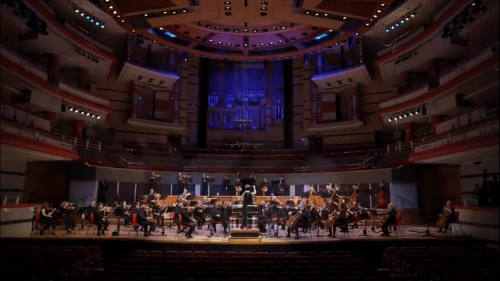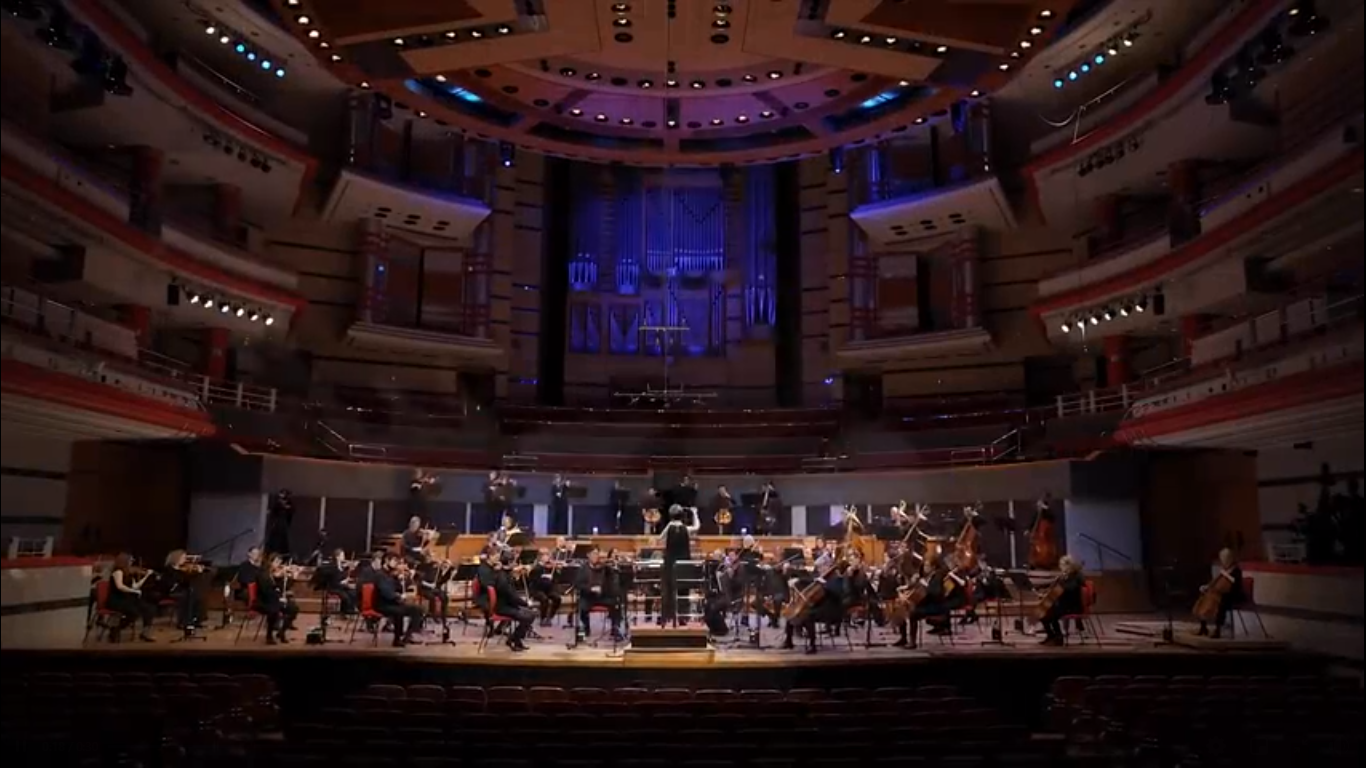 United Kingdom Ireland, Bartók, Vaughan Williams: Eugene Tzikindelean (violin/director), City of Birmingham Symphony Orchestra / Mirga Gražinytė-Tyla (conductor). Symphony Hall, Birmingham, 18.11.2020 (streamed on the CBSO website on 3.12.2020). (JQ)
United Kingdom Ireland, Bartók, Vaughan Williams: Eugene Tzikindelean (violin/director), City of Birmingham Symphony Orchestra / Mirga Gražinytė-Tyla (conductor). Symphony Hall, Birmingham, 18.11.2020 (streamed on the CBSO website on 3.12.2020). (JQ)

Ireland – Downland Suite
Bartók – Divertimento
Vaughan Williams – Fantasia on a Theme of Thomas Tallis
This was the second of the concerts recorded by the CBSO in Symphony Hall for streaming via the orchestra’s website. The first was the concert which celebrated the centenary of the CBSO’s first symphony concert (review click here). That event involved the full orchestra but for this concert a different approach was taken. The woodwind section was given the evening off and instead the programme involved firstly the brass and percussion players and, later, the string section.
First up was John Ireland’s Downland Suite; the title reflects the composer’s love of the Sussex Downs. The four-movement suite was composed in 1932 as the test piece for the National Brass Band Competition. There is a subsequent arrangement of the music for string orchestra by Ireland’s pupil Geoffrey Bush and it is quite possible that the CBSO has previously played the music in that version. I wonder, however, if the original brass score has ever featured in their programmes; quite possibly not. We heard it in a transcription for symphonic brass by Chris Mowat, the unique timbres of cornets and euphoniums were absent, of course, but I thought that Mowat’s version, as delivered by 13 CBSO brass players and three percussionists, worked extremely well. The brass players collectively produced a lovely golden tone which evoked the sound of a brass band most convincingly. I liked the sprightly and crisp account of the opening Prelude. Even better was the touching Elegy where the lovely warm sound of the brass ensemble was a decided asset. The Minuet was gracefully done and the concluding Rondo provided a most attractive conclusion. I doubt that when she accepted the CBSO job Mirga Gražinytė-Tyla imagined herself conducting British music originally conceived for brass band. However, to judge by her facial expressions she thoroughly enjoyed the experience, to which she brought her customary level of enthusiasm and engagement. This was a most enjoyable concert opener.
For Bartók’s Divertimento the orchestra dispensed with a conductor; instead, the recently appointed leader, Eugene Tzikindelean directed from the first desk. Apparently, the CBSO hasn’t played this work for more than forty years. Introducing the performance, Eugene Tzikindelean made clear his passion for the work and his affinity with it; for one thing, he comes from Transylvania where Bartók was born. I suppose I should be honest and say that I find most of this composer’s music easier to admire than to love. That said, this was a very convincing performance. It must be very challenging to play without a conductor, and all the more so when a full-sized string ensemble is involved and obliged to socially distance. However, the ensemble was both well-drilled and flexible and I never felt that the absence of a conductor was an issue.
The first movement, Allegro ma non troppo, was well shaped, the many corners negotiated skilfully. It seemed to me that Tzikindelean led the performance incisively and the players characterised Bartók’s music well. The title Divertimento implies something light, diverting but the central Molto adagio is anything but diverting. Right from the darkly oppressive opening pages this was an intense performance of deeply troubled – and troubling – music. In his introduction to the piece Eugene Tzikindelean referenced Shostakovich. In this movement I think Bartók offers something as bleak and unsettling as anything we encounter in the Soviet master’s Eighth Symphony or Eighth String Quartet. The CBSO’s performance was compelling. Bartók finds a lighter vein in the concluding Allegro assai. Much of this music is nimble and athletic; Tzikindelean and his colleagues offered a performance of great energy. Midway through the movement there’s a slower, expressive passage which is dominated by a quasi-cadenza for the leader; this gave us a good opportunity to appreciate Eugene Tzikindelean’s virtuosity. A little later, the precision of the CBSO’s ensemble work was on display in the strikingly effective pizzicato episode. This was a very good performance of a demanding work.
The concluding item was also for string orchestra and for it Mirga Gražinytė-Tyla returned to the podium. The ‘Fantasia on a Theme of Thomas is a composition that uses space to make its mark. Usually, when one talks of space in relation to this piece it’s in the context of the physical space in which it is performed. However, there was an extra spatial dimension to this performance in that all the individual players were seated at a greater distance from each other than would normally be the case. That may have made life a little more difficult for the players – though one would never have known – but as I listened through headphones, I had a terrific appreciation of the music expanding into the space around the Symphony Hall stage; the sound was marvellous. Vaughan Wiliams specifies a second, distinct and smaller group of strings. This sub-orchestra consisting of about 9 players, was positioned right at the back of the main orchestra and raised above them – the violinists and violists played standing up. The differentiation between the two ensembles worked really well in this performance. Furthermore, when the smaller group first began to play, very quietly, they made a wonderful sound: it seemed as if we were hearing not a group of stringed instruments but a softly played organ. The effect was uncanny and worked wonderfully.
The performance was an extremely fine one. Ms Gražinytė-Tyla conducted it con amore and with fine attention to detail. I appreciated the way in which she kept the music on the move whilst not undervaluing its solemn nature. She conjured a super sound and also plenty of finesse from the CBSO musicians. Special mention should be made of the solo string quartet (Eugene Tzikindelean, Peter Campbell-Kelly, Chris Yates and Eduardo Vassallo); both individually and collectively they made a refined contribution. This was a lovely performance of Vaughan William’s masterpiece.
As was the case with the previous concert in this series, the production was in the hands of River Rea Films. Once again, the company did a fine job; both the camerawork and the sound quality were excellent. I was pleased to note one improvement: while the empty auditorium remained in darkness – the right decision – this time the platform was a bit more brightly lit. The lighting was still subtle but the musicians could be seen more clearly than was previously the case; I think the lighting solution was greatly improved as a result.
This excellent concert is now available to stream from the CBSO’s website, where it will be available to view until 1 January 2021. Click here to access this concert and to get details of the next concert in the series which will feature pianist Stephen Hough and conductor Alpesh Chauhan in music by Mendelssohn. Of course, one regrets that these concerts have to be given in the absence of an audience. However, having viewed two of them I can safely say that the lack of an audience in no way inhibits the CBSO’s level of engagement with the music. And one positive feature of these lockdown concerts is that through the medium of streaming the CBSO can reach a worldwide audience.
John Quinn
